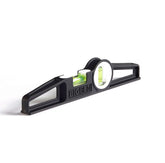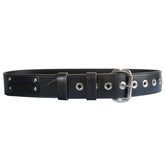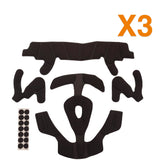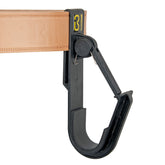Falls from height remain one of the largest contributors to workplace injuries and fatalities, according to the Health and Safety Executive (HSE)[1].
Data also suggests that ladders account for approximately 40% of all falls from height in the UK. Of increasing concern are falls from height following unauthorised access to ladders and work areas by the public, especially young children.
Sadly, there have been many recorded incidences of the public climbing onto erected scaffolds, especially in residential areas. Children have been particularly enticed to attempt a climb. Every time an unauthorised individual climbs a ladder, there is a real risk of severe injury. We must continue our efforts to promote safe use of and access to ladders.
These risks have of course called into question the safety of ladders. Many have rendered them inherently dangerous, but it must be said, this isn’t always the case.
Often the problem isn’t the ladder itself. Instead, the issue is that the right safety measures haven’t been deployed to ensure a ladder is used safely and is fit for purpose.
According to the HSE, ladders are often a sensible and practical option for low risk, short duration tasks. If a ladder has been deemed appropriate for use, it’s important to ensure you and your team:
- use the right ladder for the job
- have good knowledge and practical experience regarding the safe use of ladders
- deploy the correct preventative measures so only those with the right skills are able to access the ladder
In this guide, we’ll outline who should use the ladder and what control measures should be implemented to prevent unauthorised access to ladders.
Use of ladders on construction sites
Only those authorised to do so, and with the relevant knowledge and training, should be permitted to use ladders on construction sites.
The problem is that scaffolding can look like a welcoming playground for children, especially when erected residential areas. Children often can’t comprehend danger in the same way as adults. The best way to protect children in this scenario is to put the necessary preventative measures in place.
According to the HSE, those in charge of a project must put measures in place to prevent unauthorised access to scaffolding. They should also ensure this measure doesn’t just offer protection outside of working hours, but also while workers are present and not visible. Safety signs and information are also vital to clearly display a warning message.
Members of the public and parents do also hold some responsibility to take note of safety signs and information requesting that they keep away from areas where construction work is taking place. Sometimes, that’s easier said than done, especially when children are too young to read or understand safety signs.
What control measures should be implemented?
According to a recent safety bulletin from the HSE, the following control measures should be implemented to prevent unauthorised use of ladders:
Site perimeter fencing – If possible, site perimeter fencing should be used to block unauthorised access to ladders and the site as a whole. This fencing must be continuous and fixed in place. When deployed, fencing must be checked and reviewed on a regular basis to safeguard children from the risks of a fall.
Localised fencing to hazardous areas of a scaffold – At ground level, the full length of the scaffold may be required to be fenced. In occupied buildings or public spaces with clear access to the scaffold at several levels, fencing should be used to close off all access opportunities.
Ladder removal – When it’s been decided that a ladder should be used, it is best practice to install internal ladders or a ladder tower so that each ladder serves a single lift. This enables the ground or first lift ladder to be removed after each shift and either stored securely or padlocked to the scaffold horizontally at each end.
Ladder Guards – If it is not practical to remove the bottom lift ladder, a HSE compliant ladder guard is the best alternative. A ladder guard is a strong metal plate that hooks over and padlocks onto several rungs of the ladder to deny access. The following should apply to a HSE compliant ladder guard:
- It must be locked or padlocked in place – using a rope lashing is not acceptable.
- It must render each rung unusable – no more than 50mm of rung should be exposed when the guard is pushed as far to one side as possible.
- It should cover at least 6 rungs.
- It should not be able to slide over the ladder stile, thereby exposing the rungs.
- It must not be able to tilt or pull away from the ladder - rungs should not be exposed at the front or climbable from the rear.
- Carrying slots, if provided, should be vertical (along the long axis of the guard) not horizontal where they could be used as a foothold.
- Guards will need to be matched to certain ladders and not used on others.
- Fabric versions are not suitable for use in public spaces, or for external use in areas that may be accessed by the public, or for internal public areas that are unstaffed.
Why you need a HSE compliant Ladderguard
A ladder guard provides a physical barrier, helping prevent and deter unauthorised access to a ladder. A clear information warning sign stating a message along the lines of ‘DANGER - DO NOT CLIMB’ is also essential.
Almost a third of all reported falls from height are caused by some sort of ladder. Often, these incidents could’ve been prevented if rigorous inspection and safety measures had been implemented. Deploying a ladder guard ensures a responsible and competent person can control access to a ladder and will assign access only to trained and competent personnel.
This ladder guard from Leach’s complies perfectly with HSE’s guidelines and includes a chain and padlock, acting as the ideal deterrent against unauthorised use of site ladders.

Let’s climb safely
Honing our focus on deploying the most appropriate protective measures will help us improve the culture around safety when using ladders. At Leach’s, we always encourage on-site tradespersons to use the safest equipment possible when using ladders to ensure the safety of themselves, their teams, and the public.
Explore Leach’s range of specialist ladder safety equipment now, or contact our sales team on 01432 346890.
[1]https://www.hse.gov.uk/statistics/industry/construction.pdf


















